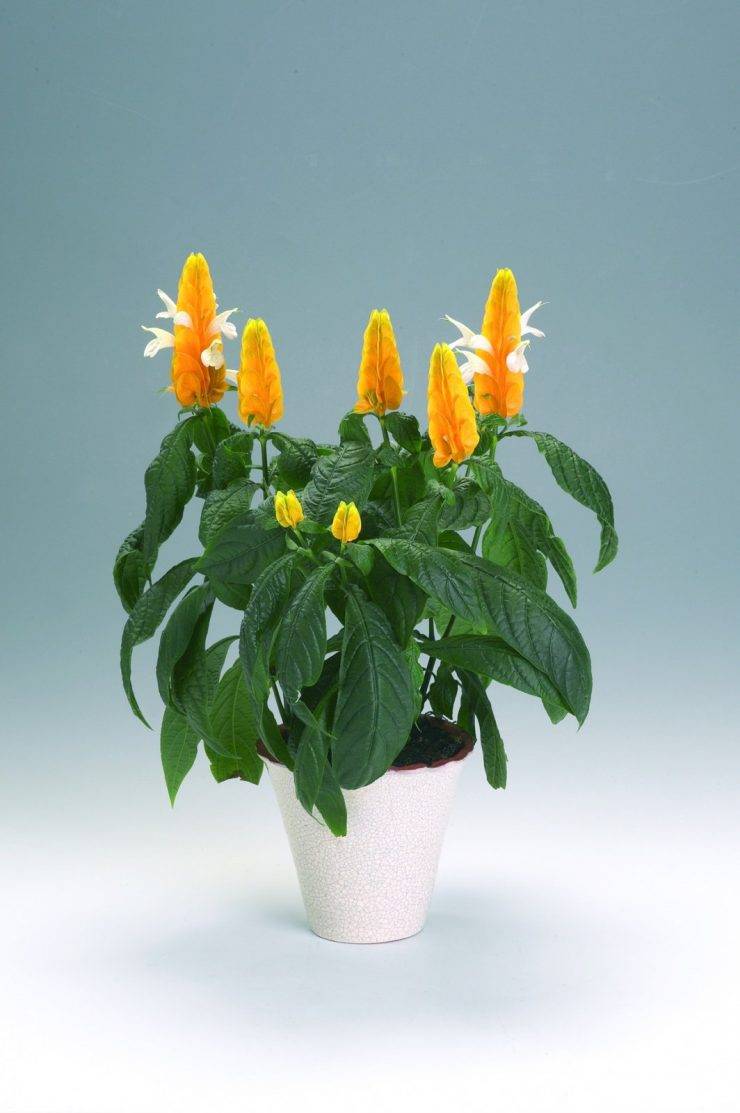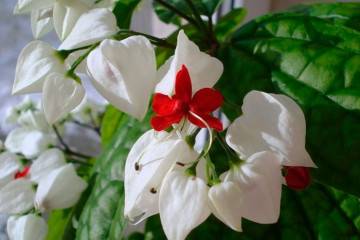Pachistachis: home care and possible problems when growing
Content:
Pachystachys is an evergreen shrub that has been blooming for many years. It belongs to the Acanthus family. It can be found in the wild in South America, Australia, India. The maximum plant height is 1 m. On the shoots there are large leaves up to 15 cm in length. Inflorescences are unusual in the form of an ear with bracts. To grow a beautiful flower, you need competent care.
Main types
There are more than 12 varieties of the plant, but some of them are not suitable for growing at home. The most common varieties are red and yellow.
Pachystachis yellow
Pachystachis yellow has the following properties:
- long shoots, the lower part of which is gradually lignified;
- the leaves are oval, the end is pointed, the width can reach 5 cm, and the length is 15 cm;
- inflorescence in the form of a spike of yellow color, small flowers have a white tint.
Pachystachis red
Pachystachis red has a lower prevalence compared to the yellow variety. In appearance, he has the following differences:
- the maximum height can reach up to 2 m, so it is not recommended to grow it at home;
- bloom is spike-shaped green, small flowers with a red tint come out of it in large quantities;
- red flowers have four elongated petals.
It is also difficult to grow a plant in the garden, since it requires special care.
Home care rules
If a florist decides to grow a plant at home, you should adhere to the recommendations for the rules of care. The optimal humidity, temperature conditions, watering are selected. Fertilizers are applied periodically so that the plant grows healthy and blooms.
Temperature
The ambient temperature should be different at certain times of the year:
- spring, summer: up to 20 ° C, but if the temperature rises higher, abundant watering and moisturizing of the leaves are necessary;
- autumn, winter: the temperature regime is from 15 ° С to 18 ° С, but not lower, since the plant belongs to thermophilic varieties.
It is not recommended to create drafts. This is important when finding a flower on a windowsill. If a window opens, it is best to close the door. If the drafts are repeated, the plant will gradually die.
Illumination
It is recommended to install the pot in a room where there is a lot of sunlight at all times. But it is forbidden to install it in open sunlight. This can cause sunburn with brown spots on the leaves.
In the summer, it is better to remove the pots from the windowsill so that the sunlight does not hit the leaves directly, but partially. In winter, you don't have to be afraid of the sun's rays, as they are less aggressive at this time of the year.
Humidity
The natural habitat of the flower is observed in hot climates with a high degree of humidity. Therefore, it is recommended to observe this point at home.All leaves are sprayed daily with a spray bottle containing clean water.
Another option is to use a moss pan with a little water. A pot with a plant is placed on top, but it should not touch the liquid. Moisture will saturate the flower, but not excessively.
Rejuvenation
Over time, when the crown grows, the upper leaves become lethargic, sparse. Therefore, you should periodically carry out the rejuvenation procedure, pruning the upper parts of the plant. The newly grown crown will be more abundant and greener.
The rejuvenation procedure is applicable already in the first year of a flower's life. Initially, only a stump of 15 cm is left above the ground. Gradually, new young shoots will appear from it. Very quickly, the crown will become abundant, the flowering process will begin.
Watering
The watering method depends on the season.
- Spring Summer. During this period, the air temperature is high, humidity decreases. Therefore, it is required to water the soil abundantly. It is recommended not to dry out by monitoring the condition of the soil in the pot.
- Winter autumn. During this period, the air temperature decreases, so the number of waterings should be made less. The flower is watered when 2-3 days have passed since the earth dries up.
Fertilizers
The flower needs feeding only during the growing season. At other times it will be superfluous. It is recommended to buy complex fertilizer in specialized stores. It is applied to the soil up to 2 times a month. Plants receive a large amount of minerals, trace elements, due to which the quality of leaves and flowers improves.
For plants, choose mineral or organic fertilizers. Agricola, aquamarine, Zhivaya Sila and other preparations have proven themselves the most.
Plant transplant and rooting
For a transplant, you must carefully prepare. The soil is preliminarily prepared so that the plant takes root in a new place. There are special transplanting rules that will allow it to grow and bloom quickly.
Soil preparation
In ordinary land, the flower may not take root. Therefore, in advance in the store they buy a universal mixture that is intended for ornamental plants. If you wish, you can cook it yourself. To do this, mix in the same part:
- sand;
- humus;
- peat land;
- leafy ground.
For transplanting, the land must be loose. This allows oxygen and moisture to pass to the lowest roots. Thanks to this, the root system will begin to increase in size, and the possibility of rotting is prevented.
Transfer
The procedure is carried out every year in any month of spring. It is best to do this when the flower has survived the pruning procedure. For transplant, the entire root system is dug out. The plant is placed in a new pot, into which a mixture of various types of soil has previously been added. In addition, a drainage layer must be lined in the pot in advance to prevent stagnation of water.
Pruning features
If pachistachis is grown at home, home care includes pruning. This is an important process on the way to the formation of an abundant crown. But it is also necessary to create a compact bush that looks good in any interior style.
If pruning is not done, you can get elongated shoots, under which there will be bare trunks. That is, the pachistachis flower will look rare, unkempt.
Pruning a pachistachis indoor flower is carried out in several stages:
- pruning should be done the first time the flower has reached 15 cm in height;
- first, pinching is done, that is, the smallest shoots are cut off, retreating from the top by 2 pairs of leaves (these pairs are pinched off);
- the procedure is then repeated every year, preferably in the spring, using the same method.
Usually flowering on young shoots occurs for the first time 3 years after planting. When this time has passed, it usually happens in winter, the bracts are cut off. It is necessary to cut off the two pairs of leaves below. This contributes to the rejuvenation of the shrub, the subsequent flowering in the spring.
Breeding method
If you want to propagate a plant or rejuvenate it, it is recommended to choose the right method.
How to propagate pachistachis at home:
- using seeds;
- cuttings.
It is better to buy seeds in specialized stores, since it is extremely difficult to get them on your own. Cultivation will take a very long time, usually the shoots do not survive, so many growers choose cuttings.
The stalk is obtained from the top of the shoot, which should be no more than 15 cm long. It is important that internodes with paired leaves are preserved.
Reproduction of pachistachis using cuttings is carried out in several stages:
- The stalk is treated with a special solution that stimulates the growth of the root system, for example, the root preparation.
- The planting material is placed in a glass of water or directly into the ground.
- If the cutting was planted in the ground, it is covered with a jar on top to create a greenhouse effect, this will allow the stem to root faster.
- The container is placed on the windowsill so that sunlight falls on it.
- In order not to overdo it with watering, it is recommended to periodically remove the jar, airing the plant, this will allow you to get young leaves as soon as possible.
- The ambient temperature must be at least 20 ° C for the leaves to appear in the next few weeks. If this happens, it is recommended to transplant the finished plant into a pot, where no further greenhouse conditions are needed.
If you want to get a flowering pachistachis, the rules of care and reproduction must be followed exactly so that the plant does not die.
Possible growing problems
Growing pachystachis yellow, violating the rules of home care, problems may arise. Therefore, many people turn to specialists with the most common questions.
- Why do pachistachis leaves curl? The plant may not be getting enough sunlight, so the leaves curl up to protect themselves. But later, if proper care is not provided, they will stop curling and become dry.
- Why doesn't pachistakhis bloom? In the process of plant breeding, it is recommended to follow all the rules of care. If pruning was not carried out in the spring, flowering will not occur, since only old shoots will be observed from above. A small amount of nutrients pass through them, so flowering is impossible.
- Why do brown or white spots appear? This may indicate that the flower has been infected with a disease. It is fungal, viral, bacterial in nature. If white spots appear, this is a symptom of the multiplication of the fungus. A brown tint occurs when infected with bacteria.
- What kind of flower is best for home? It is recommended to choose yellow pachystachis, as it grows only 1 m in height.This allows you to grow it at home.But in order to wait for abundant flowering, you need to familiarize yourself with all the rules on how to care for pachistachis.
- Why did the leaves start to fall? Falling leaves indicate insufficient watering or the use of fertilizers. Plants do not receive enough nutrients and water, so the leaves die off.
Growing a plant is not easy. But if you follow all the rules of care, problems should not arise. To achieve maximum results in the flowering process, it is recommended to timely resort to pruning, transplanting into a larger pot, which allows you to build up an abundant root system.




















